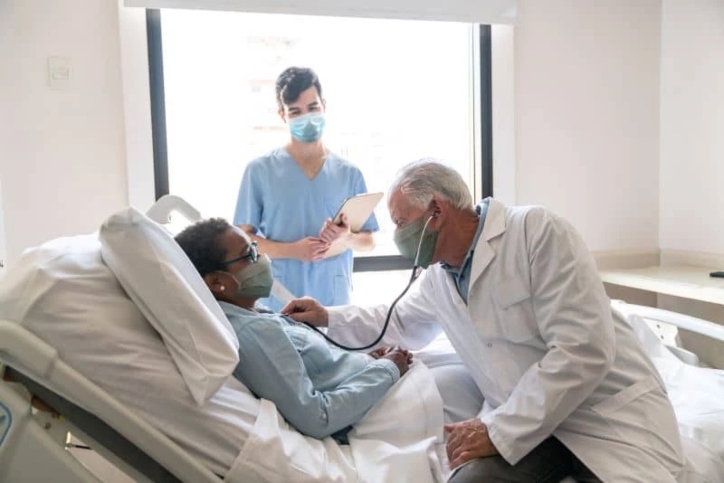
5 Ways RNs Can Improve Patient Safety
As a nurse, patient safety is your responsibility.
While the doctor is ultimately in charge of overall patient safety, physicians typically only spend 30 to 45 minutes a day caring for a patient.
For the rest of the day, you’ll be there to manage their pain, administer medications, and keep an eye out for potential complications or side effects.
Because of this, you need to make sure you’re doing everything in your power to keep your patients protected from infection, falls, medication errors, and more.
Use the following tips to enhance your safe patient handling skills to keep everyone protected during and after your shift.
5 Ways RNs Can Improve Patient Safety
1. Study Patient Safety Indicators
You’re probably familiar with Patient Safety Indicators, a set of 26 provider-level and area-level indicators that help facilities determine the rate of preventable complications in patients. Some of the more common provider-level indicators include:
- Accidental Puncture or Laceration
- Complications of Anesthesia
- Decubitus Ulcer
- Postoperative Pulmonary Embolism or Deep Vein Thrombosis
- Postoperative Sepsis
- Transfusion Reaction
While provider-level indicators happen during the initial hospital visit, area-level complications can occur during or after hospitalization and include both the principal and secondary diagnoses. Examples of area-level indicators include:
- Foreign Body Left During Procedure
- Postoperative Hemorrhage or Hematoma
- Selected Infections Due to Medical Care
Each Patient Safety Indicator is determined by taking the total outcome divided by the total population at risk.
Hospital administrators typically calculate Patient Safety Indicators as a way to understand outcome rates for the overall hospital. However, that doesn’t mean they can’t be of use to you.

Take a look at your hospital’s data and see the areas where you are weak in patient safety. Improve upon these points as much as you can, and be on the lookout for specific symptoms related to each indicator.
2. Get a Certification in Patient Safety
If you want to prove your dedication to safe patient handling, get a certification for the National Patient Safety Foundation. This organization offers the Certified Professional in Patient Safety credential to verify that you are indeed a master of safety.
So far, over 2,000 healthcare professionals have received the certification throughout 10 countries. Some of the benefits of the program include:
- Becoming more knowledgeable on patient safety skills
- Being more confident when handling high-risk patients
- Staying up-to-date with the latest patient safety trends
- Earning more credibility at your hospital
- Moving forward in your career as you surpass your peers
3. Involve Your Patients
Even if you try your best, your patient plays a primary role in their own recovery. If they don’t have the knowledge to recognize certain symptoms, you may not realize they are having a complication until it’s too late.
Therefore, involve your patients. Educate them on symptoms of common problems, and ask them how they feel every time you make your rounds.
Not only will this help while they’re in the hospital, but it will also facilitate their recovery at home or in a nursing home.
4. Take Care of Yourself
True, the patient always comes first.
But you should be a close second. If your own health is suffering because you’re pulling double shifts, not eating right, and not getting enough exercise, you simply won’t be able to provide safe patient handling.
A short study in the American Journal of Infection Control took a look at the rates of urinary tract infections and how they compared with the rates of nurse burnout.
Unsurprisingly, there were more urinary tract infections in hospitals where more nurses reported burnout. When burnout was reduced by 30 percent, infections went down by 6,239 instances.
5. Report Errors
When you make a mistake, you might be reluctant to make it known to your superiors. However, this is definitely putting patient safety at risk.
Even if someone was not harmed because of your error, in the future, that same error might cause a patient harm. Bringing an awareness of near misses helps point out vulnerabilities in the healthcare process and can lead to safe patient handling.
With these five tips in mind, your patient safety skills should definitely improve.
Additional Nursing Resources:
- AMN Passport: Our all-in-one nursing app for booking nursing jobs.
- Nursing Salary & Benefits: AMN Healthcare offers our nurses some amazing salaries and benefits. Find out what's in store for your nursing career today.
- Travel Nurse Licensing: Find out about nursing requirements for all 50 states.
- Exclusive Facilities: AMN Healthcare has relationships with the most sought-after healthcare providers.
- Refer-a-Friend: Make up to $2,000 per referral.
Latest News
Part 2 - The Other Side of the Bed: A Journey of Resilience and Advocacy with Sarah Boes
Hear Sarah Boes’ journey of resilience, mental health, and nursing innovation. This episode of Nursing Uncharted will inspire nurses and students.
Operating Room (OR) Travel Nursing Jobs: Requirements, Pay and Best Locations
Explore OR travel nursing jobs. Learn about requirements,
Operating Room (OR) Travel Nurse Salary: How Much Can You Make in 2025?
Discover the earning potential and perks of operating room travel nurse jobs in 2025. Learn how to maximize your salary and find top-paying contracts.
Top Medical Surgical Travel Nursing Trends You Need to Know
Discover the latest trends in Med-Surg travel nursing, from high-demand locations to innovative care technologies. Maximize your career opportunities today!
How to Balance Work & Travel as a Med-Surg Travel Nurse
Learn how med-surg travel nurses can balance demanding work schedules with travel adventures. Find tips for time management, self-care, and choosing assignments.
Best Cities for Telemetry Travel Nursing Jobs
Discover the best cities for telemetry travel nursing jobs in 2025, exploring opportunities in Austin, San Diego, Atlanta, and more. Get insights and career tips today!
ICU Travel Nurse Jobs: Certifications That Boost Your Pay
Want better pay and opportunities as a travel nurse? Boost your skills with these certifications tailored for ICU travel nurse jobs. Learn more today!
Essential Skills Every Telemetry Travel Nurse Needs
Master these 7 telemetry travel nurse skills to thrive in











